Grasshopper Look-Alikes: Katydids, Crickets – Identification Guide
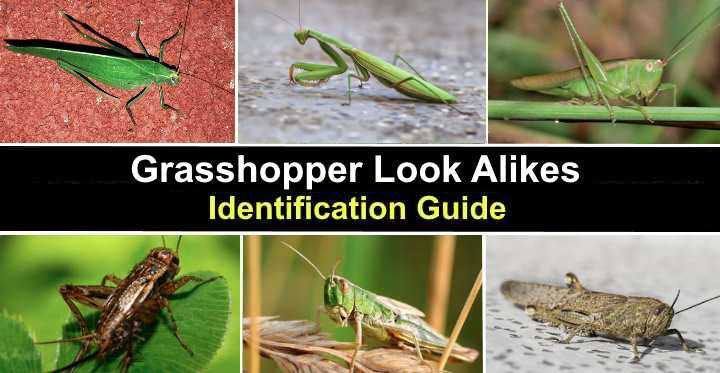
Katydids and crickets are two types of insects that look like grasshoppers. Some species of these grasshopper look-alikes have the characteristic slender bodies and large hind legs like grasshoppers. And like grasshoppers, many of these species make ticking or clicking sounds when rubbing their wings together. These similarities can make differentiating crickets and katydids from grasshoppers challenging.
However, there are distinguishing features to help identify grasshoppers and spot their look-alikes. Looking at their size, body shape, antennae, behavior, and color can help to tell katydids, crickets, praying mantises, and stick insects apart from grasshoppers.
This article is an identification guide to help tell the difference between katydids, crickets, locusts, and other similar insects.
So, suppose you have noticed chirping insects hopping around your garden and want to identify them. In that case, this article has helpful information on recognizing if it’s a grasshopper or grasshopper look-alike.
Insects That Look Like Grasshoppers
Some insects look like grasshoppers because they have large hind legs they use to leap, they can fly, or make rapid tic-tic noises. Crickets and katydids are two insect species most closely resembling grasshoppers. However, stick insects and praying mantises look like some grasshopper species, especially silent slant-faced grasshoppers.
Telling similarly-looking insects from grasshoppers apart gets more confusing because some share similar common names. For example, katydids are also called bush crickets and long-horned grasshoppers. However, bush cricket is also a subfamily of true crickets that look like grasshoppers. Additionally, they belong to the same insect order Orthoptera.
How to Tell Grasshoppers, Katydids, and Crickets Apart
There are a few ways to differentiate between similar-looking insects in the order Orthoptera.
For example, look at the antennae. Grasshoppers tend to have short, thick antennae, whereas crickets and katydids have long, thin antennae. Grasshoppers are usually active in daylight, but katydids feed at night. And crickets have a more diverse habitat than grasshoppers or katydids.
Related reading: How to get rid of grasshoppers from our yard.
Katydids (Tettigoniidae)
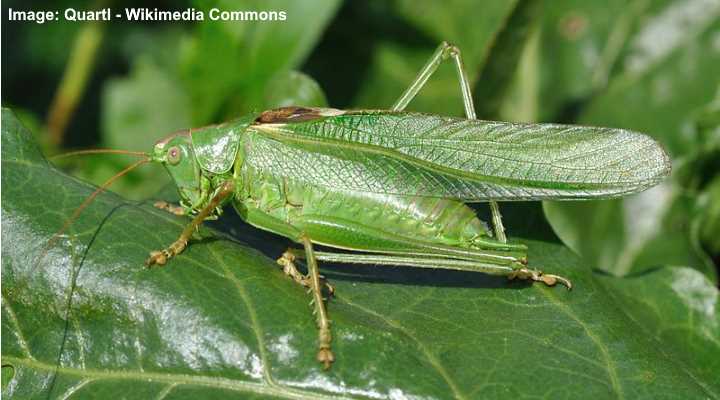
Katydids are also called bush crickets or long-horned grasshoppers. In the picture: the great green bush-cricket (Tettigonia viridissima)
Katydids are green-winged insects that look and sound remarkably like grasshoppers. These grasshopper look-alikes have long, threadlike antennae, a pair of wings they use to “sing” with, and large, angled hindlegs. Katydids typically live in trees and are only active at night when you can hear their distinctive sounds.
Some katydids are gigantic insects that grow up to 5.1” (130 mm) long — much larger than the world’s largest grasshopper. However, katydids can also be small green insects measuring as little as 0.20” (5 mm). The grasshopper-like creatures are common in tropical regions, but many species are native to North America.
How to tell katydids and grasshoppers apart? The main difference between katydids and grasshoppers is their long, filamentous antennae which can be longer than their body length. In contrast, the grasshopper antennae are short and stumpy. Additionally, katydids are nocturnal, whereas grasshoppers are active in the daytime.
Katydids are commonly called bush crickets or long-horned grasshoppers.
Let’s look at some individual species of katydids that look like grasshoppers.
True katydids (Pseudophyllinae)
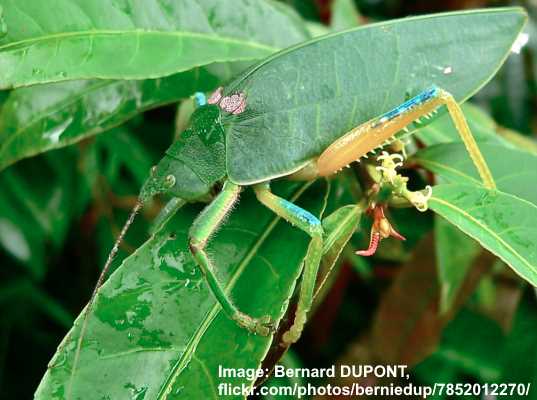
Leaf-mimic katydid (Phyllozelus caeruleus)
True katydids make up several tribes of grasshopper-like insects in the subfamily Pseudophyllinae. These green insects are characterized by their remarkable appearance, resembling leaves. Their large wings have veins and blotches like tree leaves. For this reason, some katydids are called leaf-mimic katydids.
There is great variation in species of katydids in the subfamily Pseudophyllinae. For example, some have wings with gray and white mottled patterns resembling dried, decaying leaves. However, other katydids look like beautiful red butterflies with yellow and deep red marks on their wings.
Meadow katydids (Conocephalinae)

The long-winged conehead katydid (Conocephalus fuscus)
Meadow katydids closely resemble grasshoppers with their long slender bodies, large ‘V’-shaped hind legs, and vertically aligned heads. For example, the long-winged conehead katydid (Conocephalus fuscus) has a saddle-shaped thorax, long forewings, and a distinctive stripe along its abdomen. This katydid species measures 0.63” to 0.87” (16 – 22 mm) long.
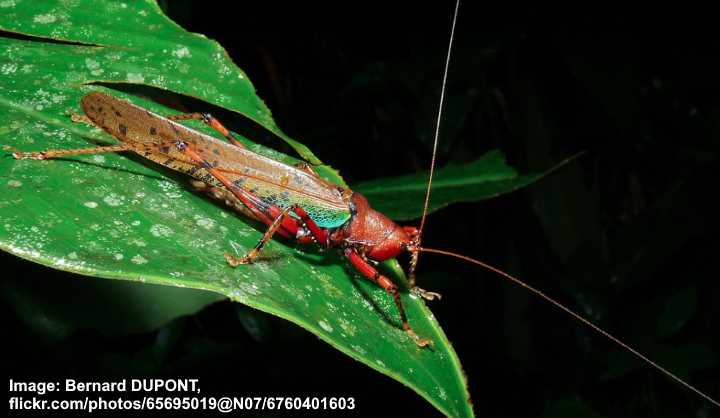
Eumacroxiphus brachyurus looks like a red grasshopper
Among the many species of meadow katydids are insects that look like red grasshoppers (Eumacroxiphus brachyurus). These colorful katydids have red abdomens, black-banded red legs, and reddish-green wings. They also have exceedingly long threadlike antennae. However, the Orchelimum pulchellum is a green katydid with emerald-green wings and yellowish and red hindlegs.
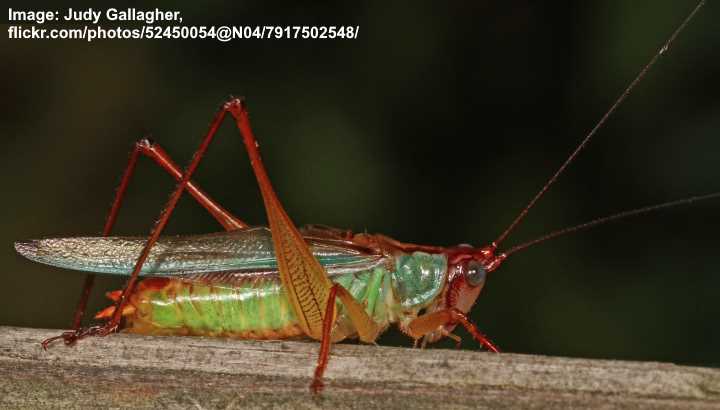
The handsome meadow katydid (Orchelimum pulchellum)
Predatory katydids (Saginae)

The spiked magician (Saga pedo)
Many species of predatory katydids look like gigantic grasshoppers, and it’s easy to confuse them. For example, the spiked magician (Saga pedo) bush cricket is a wingless insect with a long slender body and huge rear legs. The katydid has a dull green body and legs with a yellowish stripe along its abdomen.
Also called the predatory bush cricket, the spiked magician is enormous, measuring 4.7” (120 mm). This makes it one of the largest katydids that looks like a grasshopper. The katydids inhabit pastures, meadows, and shrubs, as well as grain fields.
As their name suggests, predatory katydids hunt their prey, and their diet consists of small insects.
How to get rid of katydids in the garden
Although they don’t damage plants extensively, some people consider katydids unwelcome flying bugs in the garden. For example, the broad-winged katydid (Microcentrum rhombifolium) eats the foliage of citrus trees and can destroy immature species. The katydid bugs also nibble on citrus fruit peel.
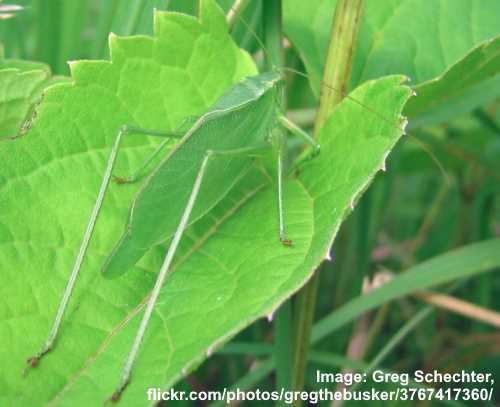
The broad-winged katydid (Microcentrum rhombifolium)
The best way to get rid of katydids if they become pests is to use spinosad early in the season to destroy katydid nymphs. However, getting rid of katydids from your garden entirely is difficult.
Crickets (Grylloidea)
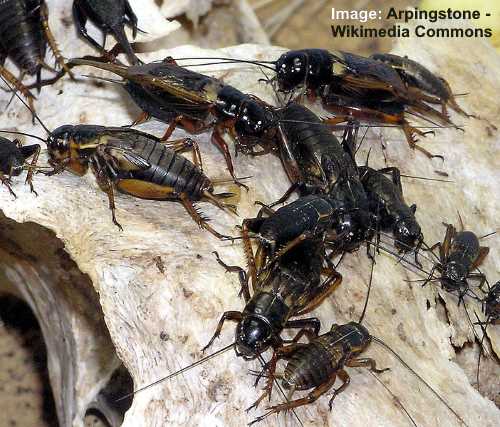
African field crickets (Gryllus bimaculatus)
Crickets are related to grasshoppers and katydids but are generally smaller, cylindrical insects with flattened bodies. Like katydids, crickets have long threadlike antennae and robust hind legs for leaping, and they also make chirping noises. However, although crickets have wings, they are not adapted for flying. Therefore, crickets are typically ground-living insects.
Grasshopper-look-alike crickets in North America are typically olive-green, brown, or black insects. Most species are characterized by a rounded head with huge antennae. Additionally, many types of crickets have a pair of tail-like protrusions. The small insects typically measure between 0.47” and 2.0” (12 – 25 mm).
Unlike grasshoppers, crickets have a wide distribution and are found in most countries worldwide. You can find them in the tropics and temperate regions. And they live in bushes, forests, marshes, grasslands, and beaches.
How can you tell crickets apart from grasshoppers? Compared to grasshoppers, crickets have a more oval body and rounded head. In addition, while grasshoppers have short, stubby antennae, crickets have long antennae, which are usually longer than their bodies. Also, crickets cannot fly but scurry across the ground.
Let’s look at some individual cricket species that you could mistake for small grasshoppers.
Sword-tail crickets (Trigonidiinae)
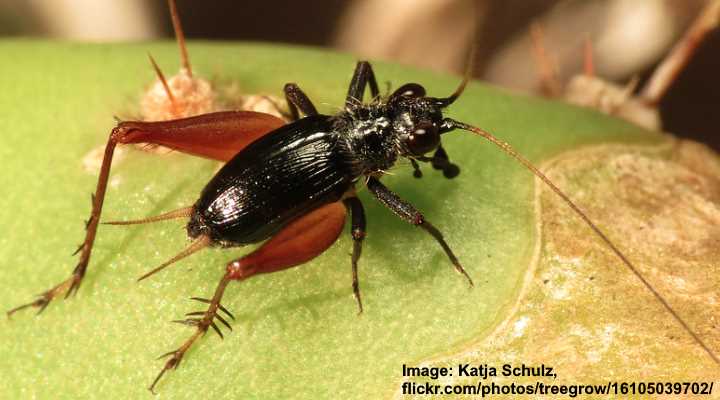
The sword-tail cricket Trigonidium cicindeloides
Also called winged bush crickets or trigs, sword-tail crickets mostly look like small grasshoppers. Sword-tail crickets have characteristic large hind legs, long, wandering antennae, and an oval body. Depending on the individual species, the small crickets could be black, brown, or yellowish-green. These ground insects are common throughout North America.
Sword-tail crickets generally grow between 0.15” and 0.35” (4 – 9 mm). They get their name from the two pointed protrusions at their tail end. Additional characteristics of sword-tail crickets are noticeable spines on their hind legs, large eyes, and colorful hindlegs.
Ground crickets (Nemobiinae)
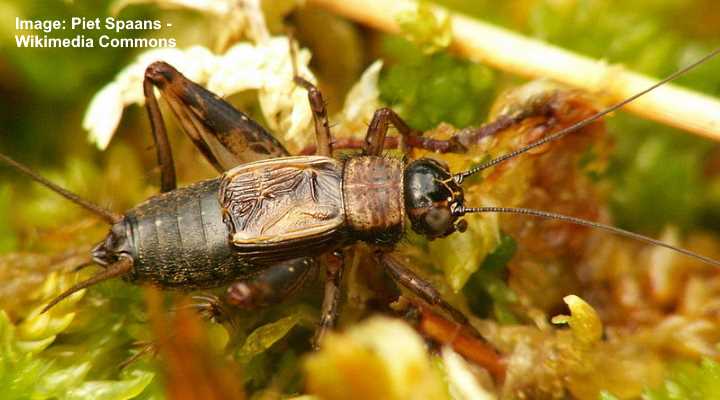
Wood cricket (Nemobius sylvestris)
Ground crickets are small insects that look like tiny grasshoppers. Also called wood crickets, the insects have a flattened, oval body, round head, and two long antennae—although usually shorter than those on other crickets. Typically, ground crickets measure less than 0.6” (15 mm) long.
Ground crickets are omnivores and are active during the daytime. Most of the 200 species in the subfamily are small brown insects. This camouflage makes the insects hard to spot among leaf litter and at the base of plants where they typically live.
Mole crickets (Gryllotalpidae)
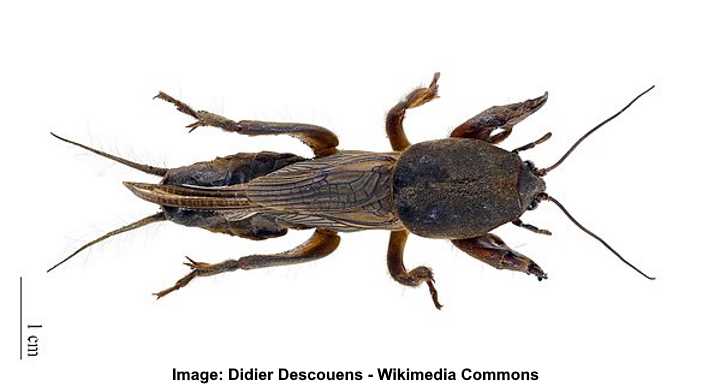
European mole cricket (Gryllotalpa gryllotalpa)
Mole crickets are a group of grasshopper look-alikes with cylindrical bodies, small eyes, and six legs. As their name suggests, mole crickets mostly live underground. Common features of mole crickets are their slender appearance and relatively large head and thorax. Although their legs resemble those of a true cricket, they are more adapted for pushing soil than leaping.
Mole crickets are mid-sized insects measuring 1.3” to 1.4” (3.2 – 3.5 mm) long. A unique feature of these crickets is their ability to fly. However, they spend their lives in underground burrows where they feed, mate, and keep safe from predators. In addition, they feed on other species of crickets, larvae, roots, and worms.
Field crickets (Gryllus)
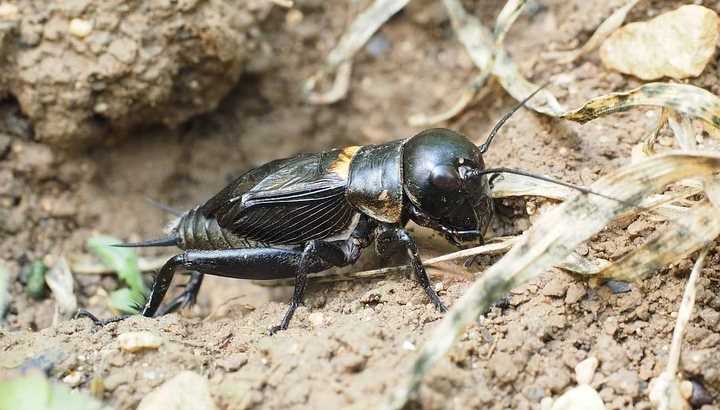
The European field cricket (Gryllus campestris)
Field crickets are darkly colored insects with hind legs characteristic of grasshoppers. The dark brown to black crawling insects have an oval body, a round head vertically aligned, pair of wings, and two pointed tails. They also have spines or pegs on their rear legs to make their chirping sounds.
There are hundreds of kinds of field crickets, and they generally measure 0.59” to 1.22” (15 – 31 mm) long. The crickets tend to prefer sunny locations and dry conditions. As their common name suggests, they live in grasslands, feeding on various types of grasses.
Bush Crickets (Eneopterinae)

Bush cricket Eneoptera guyanensis
Bush crickets are the type of insect that mostly resembles grasshoppers. Generally, their body shape, hind legs, and vertically aligned head make them easy to confuse with grasshoppers. And although katydids are also called bush crickets, the species are related but not the same.
Locusts
Locusts look like grasshoppers because they are true grasshoppers. Locusts are a species of short-horned grasshopper with large hindlegs, flight wings, and characteristic short stumpy antennae. Locusts differ from other grasshoppers due to their gregarious phase. This is where they rapidly multiply and swarm in many numbers, sometimes with millions of insects.
Swarming grasshoppers (locusts) are relatively large insects that grow up to 3.14” (80 mm) in length. For example, the desert locust is one of the largest grasshoppers that flies. However, there are smaller species of locusts as small as 0.4” (10 mm).
Let’s look in more detail at identifying features of some common types of locusts.
Migratory locusts (Locusta migratoria)

Migratory locust (Locusta migratoria)
The migratory locust is a large insect with a yellowish body and brown wings featuring yellow patterns. This destructive pest has large hindlegs with dark brown to black ‘V’-shaped marks and small spikes. Like most types of locusts, this grasshopper species has short, straight antennae.
The migratory locust grows between 1.57” and 2.36” (40 – 60 mm) long. It is common in Africa and Asia. Like many species of locusts, this one has different coloration depending on its phase. It is yellow-brown in its gregarious adult phase but brown with patches of green in its solitary phase.
Desert locusts (Schistocerca gregaria)
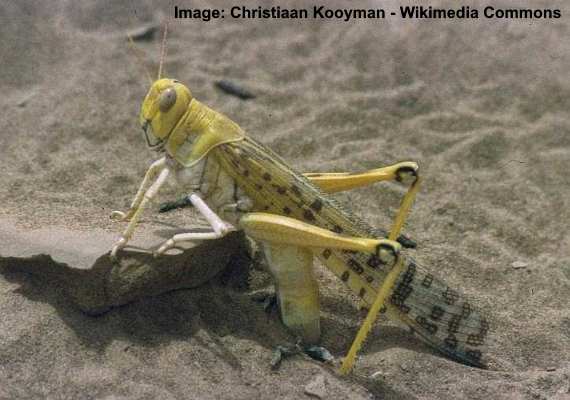
Desert locust (Schistocerca gregaria)
The desert locust is a large grasshopper with an overall yellowish-green color. The identifying features of the destructive insect are black patches on its wings, bright yellow head and hindlegs, and whitish-gray forelegs. However, in the gregarious phase, they develop pink patches. Like all grasshopper insects, this locust has short antennae.
The desert locust is a huge insect that measures around 3.14” (80 mm) in length. As its name suggests, it inhabits African, Asian, and Middle Eastern regions. Swarms of these locusts can amount to tens of millions and cause extensive crop damage.
Garden locusts (Acanthacris ruficornis)
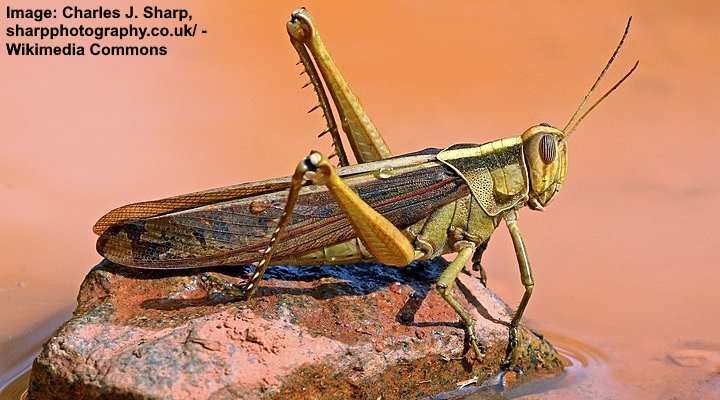
Garden locust (Acanthacris ruficornis)
The garden locust is another huge, short-horned grasshopper with swarming tendencies. It has dark brown wings and a yellowish-brown thorax and head. Identifying features of this swarming grasshopper are the yellow stripe along its head and thorax, horizontally striped compound eyes, and yellow and brown hind legs.
The enormous grasshopper can measure up to 3.14” (80 mm). Under optimal conditions, garden locusts are just as destructive as other species of swarming grasshoppers. They prefer to live in warm habitats where they can be active throughout the year.
Stick Insects (Phasmatodea)
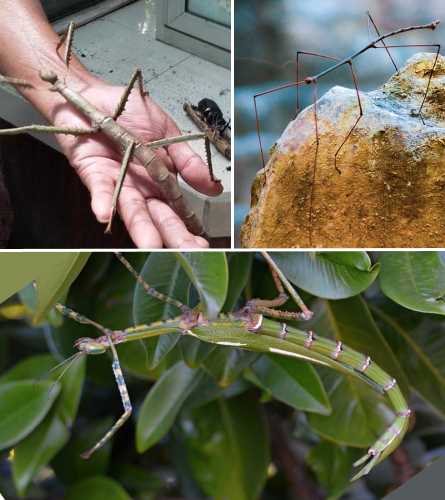
Stick insects include many species with varying sizes and colors
Stick insects are a species of insect that resembles silent slant-faced grasshoppers. The unusual creatures have long, cylindrical, stick-like slender bodies and long outstretched legs. These insects are typically green or brown and have wings, although they cannot fly. Stick insects have the remarkable ability to mimic their surroundings.
Stick insects can be enormous insects and are classified as the world’s longest insects. The largest stick insect in the genus Phryganistria grows 25” (640 mm) long. However, some smaller stick insects can be as tiny as 0.6” (15 mm).
Also called walking sticks, these types of leaf insects are found in temperate and tropical regions of the world. They inhabit forests and woodlands and are difficult to spot because of their excellent camouflage. Other names for these insects include stick bugs, phasmids, ghost insects, and leaf bugs.
Praying Mantis (Mantodea)
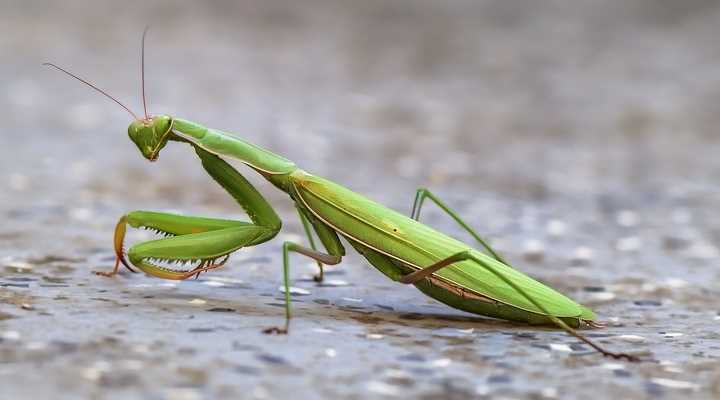
The European mantis (Mantis religiosa)
The praying mantis is an unusual green insect that can be mistaken for a large grasshopper. The unmissable features of mantises are their triangular head with bulging eyes, elongated, slender bodies, and enlarged forelegs to grip their prey. Their name comes from the way they fold their forearms in a praying position when in an upright posture.
Praying mantises range in size from 2” to 5” (50 – 120 mm). Although green is their typical color, the insects can also be brown or yellowish-green. A characteristic habit of the praying mantis is that they can remain motionless for extended periods. However, if they are threatened, they rise up on their hind legs and spread their forearms in an aggressive pose.
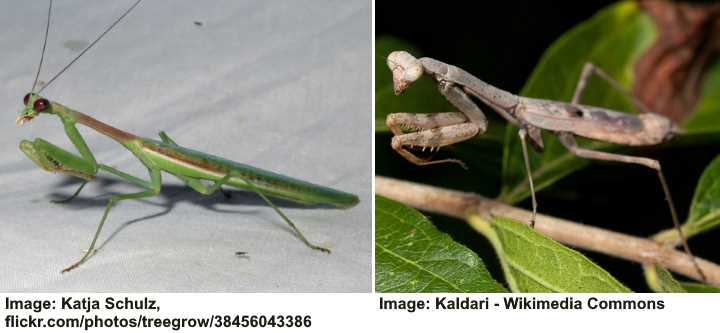
Native North America praying mantises: left: Arizona mantis (Stagmomantis limbata). Right: Carolina mantis (Stagmomantis carolina)
Several species of praying mantises are native to North America. They are most commonly found in the southwestern United States. For example, the Arizona mantis (Stagmomantis limbata) is a pale-green winged insect measuring 3” (75 mm) long. On the other hand, the native Carolina mantis (Stagmomantis carolina) is a gray to dusty-brown insect found throughout the east coast.
Related articles:
